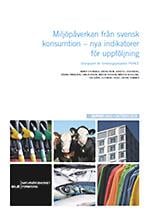Policy-Relevant Indicators for National Consumption and Environment (PRINCE)

About this report
PRINCE was particularly linked to follow-up of the Generational Goal, the overarching goal of Swedish environmental policy, which calls for the major environmental problems within Sweden to be solved within a generation, without causing increased environmental and health problems outside Sweden’s borders.
The project consortium of research institutes led by Statistics Sweden developed a new methodology for combining Swedish environmental-economic data with an environmentally extended multiregional input-output (MRIO) model, EXIOBASE. This made it possible to estimate the environmental pressures resulting from producing goods and services consumed in Sweden, based on reliable economic data and “environmental extensions” to reflect the characteristics of productive industries in different parts of the world in a given year.
The MRIO and Swedish data were combined in a hybrid model, which the project used to investigate an unprecedented wide range of environmental pressures associated with Swedish consumption. In addition to greenhouse gas (GHG) emissions and air pollutants, PRINCE investigated pressures resulting from use of a number of natural resources (land use, blue water consumption, and an aggregate measure of materials use) as well as pressures not previously used to generate national-scale indicators, such as aggregate use of chemicals, and GHG emissions from deforestation coupled to consumption. For some pressures, it was possible to develop indicators that can be adopted into calculation of environmental pressure from consumption as part of the environmental accounts. Others were more experimental.
For many indicators, the project was able to generate a time-series of results for the period 2008–2014. These were chiefly for emissions to air often associated with – but not limited to – the use of fossil fuels, along with land use, blue water consumption and materials use.
These time-series revealed that emissions of GHGs, nitrogen oxides (NOx), sulphur dioxide (SO2) and particulate matter (PM2.5 and PM10) associated with Swedish consumption had all decreased during the period. The land area used to produce goods and services consumed in Sweden had also decreased somewhat, while total material flows (by weight) increased.
